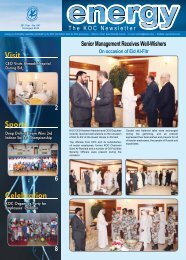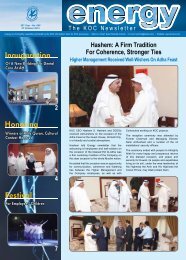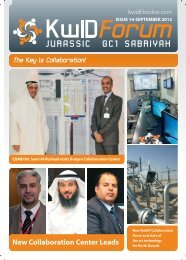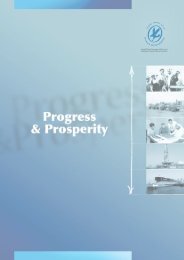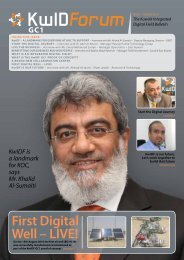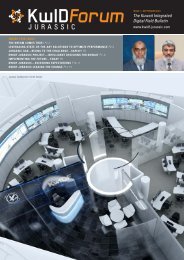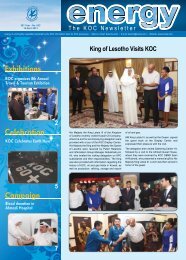4 - Kuwait Oil Company
4 - Kuwait Oil Company
4 - Kuwait Oil Company
Create successful ePaper yourself
Turn your PDF publications into a flip-book with our unique Google optimized e-Paper software.
The Benefit of Variable Speed Drives for KOCOperationsSubmitted by: Ahmad Jumah Al-Qallaf, Engineer Elec. Maint., Operations Support GroupFor centuries, machinery andmotors have been the coreaspect of the industrial processwhich symbolizes growth andprogress. Semiconductors haveplayed a leading role and haverepresented the heartbeat of anevolving world that has witnessedimprovements in all aspectsof industrial life. In addition,machineries and motors have hada fair amount of time to progressand develop over the years toovercome their weaknesses andshortfalls in terms of mechanicaland electrical stress duringstartup and speed control.And thanks to semiconductors,electrical drives known asVariable Frequency/SpeedDrives have been introducedto the industrial market as anenhancement to AlternatingCurrent (AC) motors.Pilot’sObjectivesDescriptionA variable-frequency drive (VFD),also called “variable-speed drive,”is a type of adjustable-speeddrive used in electromechanicaldrive systems to control AC motorspeed and torque by varyingmotor input frequency andvoltage.Fixed-speed operated loadssubject the motor to a highstarting torque and to currentsurges that are up to eight timesthe full-load current. AC drivesinstead gradually ramp themotor up to operating speed toreduce mechanical and electricalstress, reducing maintenance andrepair costs, and extending thelife of the motor and the drivenAhmad Jumah Al-QallafEngineer Elec. Maint., OperationsSupport Groupequipment.The following are process controlbenefits that might be providedby VFDs:• Smoother operation.• Acceleration control.• Different operating speed foreach process mode.• Compensate for changingprocess variables.• Adjust the rate of production.The task of a variable speedelectrical drive is to convertthe electrical power suppliedby the mains into mechanicalpower with a minimum amountof loss. This is ensured by thelow loss control using solidstate technology in electroniccontrollers. The solid statetechnology is used to achievean optimum process to drive themotor with varying its speed.The controllers are connected toa mains supply and the electricalFigure 1 VSD System Configurationmachine as shown in Figure 1.The solid-state devices convertthe AC supply to DC supply byusing the armature voltage ofa DC motor, and therefore thespeed can be adjusted, almostwithout losses and over a widerange of speed. This helps tomaintain the desired selectedspeed, independently of the loadand operated with good dynamicresponse.Recently, technology hasimproved VFD (VariableFrequency Drive) performancethrough advances insemiconductor switching devises,drive topologies, simulation andcontrol techniques.Pulse Width Modulation - PWMPulse Width Modulation (PWM)is the method of control wherevariable voltage (AC/DC) isachieved from a fixed DC voltageusing switching devices. DCvoltage is applied for some timein the cycle and in the remainingperiod, no voltage is applied tothe load. By adjusting the dutyratio, (ratio of on period to cycletime) output voltage is adjustedbetween zero and rated voltage.Scalar ControlIn scalar control, the relationshipbetween voltage and frequencyof the AC voltage applied to themotor terminals is predeterminedby the user. This relationship issometimes marginally alteredin scalar drives to improve theperformance of the drive. Scalarcontrolled inverters can only havespeed control, and these are idealfor group/multi motor drives.At <strong>Kuwait</strong> <strong>Oil</strong> <strong>Company</strong>, variable20October - December 2012



